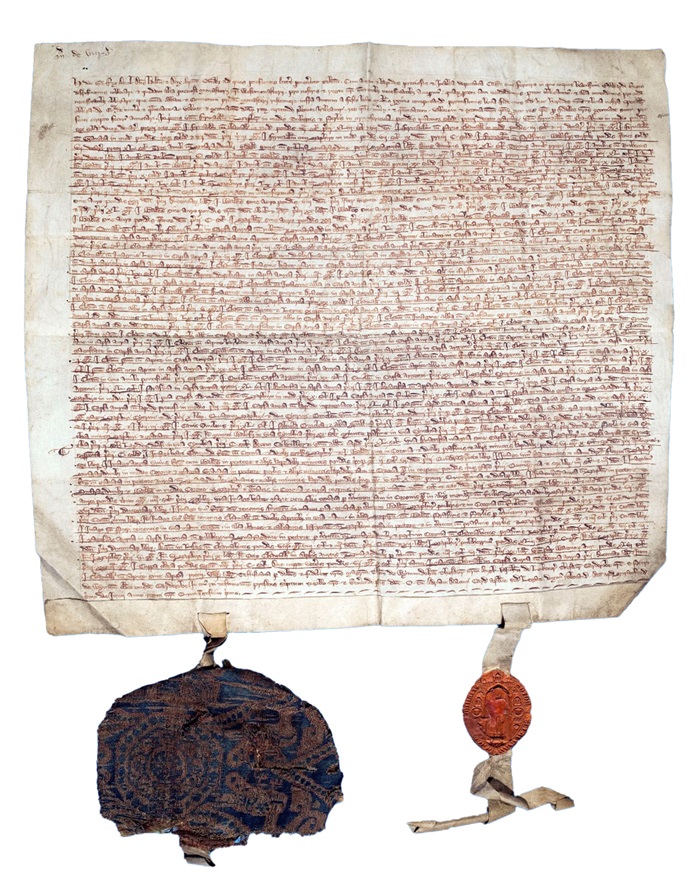Aberystwyth historian helps unravel mystery of medieval silk bag

Dr Elizabeth New, Aberystwyth University
17 December 2024
An Aberystwyth University academic is part of an international team that has made an exciting discovery linking an 800-year-old silk bag at Westminster Abbey with Charlemagne, the first Holy Roman Emperor.
The project team, which includes Dr Elizabeth New, a Reader in medieval history at Aberystwyth, has carried out an in-depth study of a medieval silk bag covering the great seal of King Henry III on a document preserved at Westminster Abbey.
Dr New is an expert in wax seals which were a familiar part of everyday life in medieval times, much like signatures and logos are today.
Few of the silk coverings which wrapped wax seals survive, and those that do have received little attention from researchers until now.
Remarkably, however, a collection of over sixty such bags have been preserved in the collections of Westminster Abbey, offering a rare opportunity to study medieval textiles.
The silk bag studied by the research team covers the sovereign’s seal which was attached to a parchment inventory dated 1267.
Seven years of war and several expensive building projects had drained the Exchequer, and the inventory recorded the items that the king was removing from the shrine of St Edward the Confessor at Westminster Abbey - the customary burial site of the kings and queens of England - to pawn, promising to return them within 18 months.

Henry III inventory from 1267 by kind permission of the Dean and Chapter of Westminster
The ancient bag is made from two separate pieces of expensive, patterned silk. The more ornate of the two, which covered the front of the seal, has a floral pattern and shows a hare standing on its hind legs, beneath a bird with claws and wide-spread wings.
The researchers ascertained this silk is identical to the pattern and woven structure of the famous ‘hare silk’ used as a burial shroud for the remains of Emperor Charlemagne when he was reinterred in Aachen Cathedral in Germany in 1215.
It is thought the Aachen Cathedral silk was likely woven before 1215 in the Eastern Mediterranean or Spain. The project team believe the Westminster Abbey silk was woven in the same workshop, conceivably on the same loom and by the same weaver.
Dr Elizabeth New from Aberystwyth University said:
“The exciting discoveries we have made through an in-depth study of just one of about 65 seal bags preserved in Westminster Abbey, clearly demonstrates the potential for further research on medieval textiles, seals and historical documents.
“Each of these seal bags is unique and each will have its own unique story. Some of the textiles are over 1000 years old, others go back 600-700 years. Some have come all the way along the ancient Silk Road, crossing from the Islamic world to northern Europe. Together, they open a new window to historians on the trade and cultural connections of the Middle Ages.”
The medieval silk seal bag studied by the project team has now gone on public display for the first time in the Queen’s Diamond Jubilee Galleries at Westminster Abbey, where it will be exhibited until Easter 2025.

The Henry III silk bag studied by the project team, by kind permission of the Dean and Chapter of Westminster
Other members of the international research team are Professor Corinne Mühlemann from the Institut für Kunstgeschichte (Institute of Art History) at the University of Bern; Dr Matthew Payne, Keeper of the Muniments at Westminster Abbey; Helen Wyld, Senior Curator of Historic Textiles at National Museums Scotland.
The academic findings of the project team have been published in the December 2024 edition of the Burlington Magazine, a leading journal of art history and criticism.

